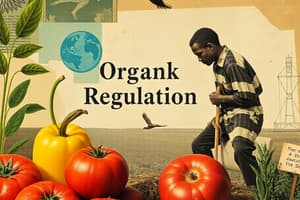Podcast
Questions and Answers
Match the following characteristics with their corresponding food types:
Match the following characteristics with their corresponding food types:
Organic foods = Higher in antioxidants Non-organic foods = Achieve perfect shapes due to chemicals
Match the following nutrients with their increased presence in organic foods:
Match the following nutrients with their increased presence in organic foods:
Iron = Higher in organic foods Zinc = Higher in organic foods Vitamin C = Higher in organic foods Cadmium = Absent in organic foods
Match the reason for the demand increase with its corresponding explanation:
Match the reason for the demand increase with its corresponding explanation:
Safer foods = Perceived lower pollution risk Healthier foods = Higher quantities of antioxidants Tastier foods = Natural flavor without additives Natural appearance = Imperfect shapes of organic foods
Match the following terms with their definitions:
Match the following terms with their definitions:
Match the following markets with their corresponding trends regarding organic foods:
Match the following markets with their corresponding trends regarding organic foods:
Study Notes
Demand for Organic Foods
- Increased demand for organic foods observed over the last twenty years, particularly in the USA and many European markets.
- Consumers perceive organic foods as safer, tastier, and healthier compared to non-organic alternatives.
- Environmental concerns contribute to the rising popularity, as organic foods are associated with lower pollution risks.
Characteristics of Organic Foods
- Defined as foods grown without artificial chemicals or genetically modified substances.
- Organic foods are free from artificial additives, including preservatives, flavorings, sweeteners, and colorings.
- In contrast, foods grown using chemicals are categorized as inorganic.
Nutritional Differences
- Studies indicate that organic foods possess higher levels of antioxidants compared to non-organic foods.
- Certain micronutrients, such as iron, zinc, and vitamin C, are found in greater quantities in organic foods.
- High antioxidant content in organic foods plays a role in reducing the risk of chronic illnesses.
Pesticide Concerns
- Non-organic foods may contain toxic pesticides, such as cadmium, which are absent in organic foods.
- Organic farming practices focus on reducing exposure to harmful chemicals, promoting safety for consumers.
Visual and Textural Differences
- Organic foods typically have a more natural appearance, reflecting their unsprayed and untreated nature.
- Non-organic foods often exhibit nearly perfect shapes due to chemical treatments, leading to a less natural look.
Studying That Suits You
Use AI to generate personalized quizzes and flashcards to suit your learning preferences.
Description
Explore the rising demand for organic foods and their perceived advantages over non-organic alternatives. This quiz covers the characteristics that define organic foods, their nutritional benefits, and the environmental impacts associated with organic farming. Test your knowledge about the organic food industry and its effects on consumer health.




